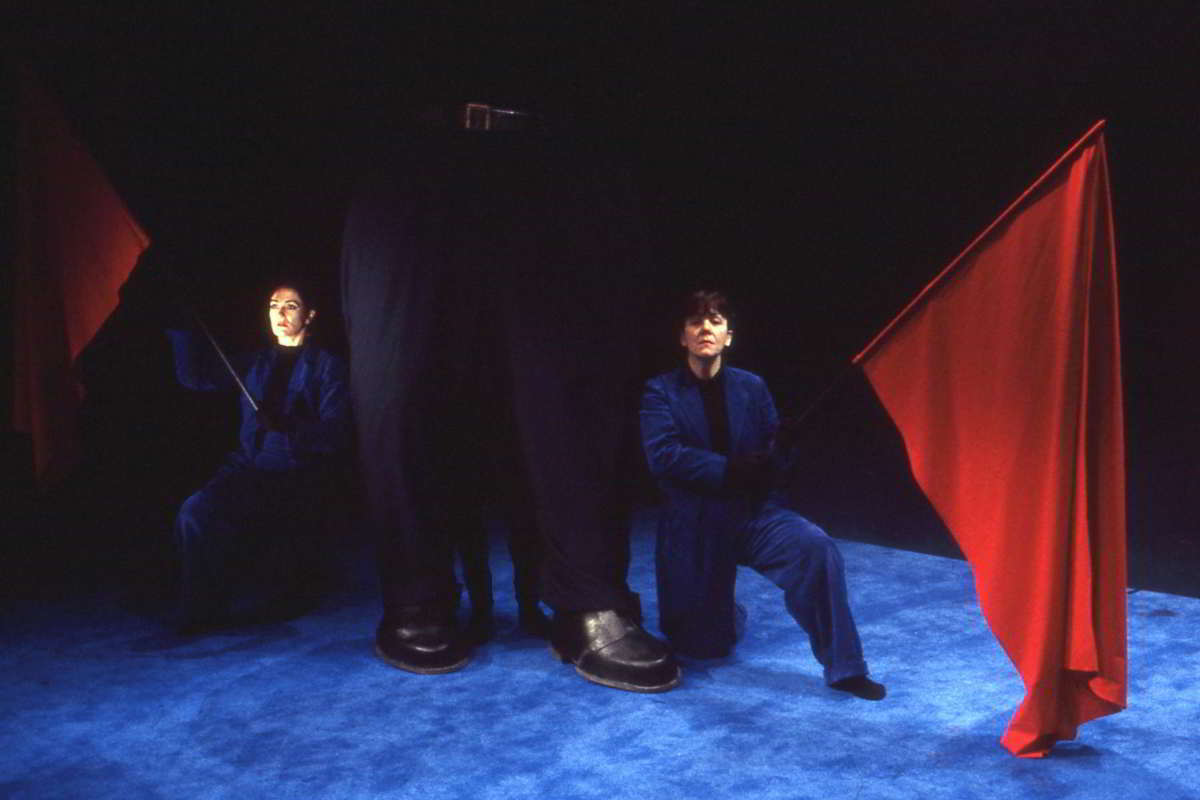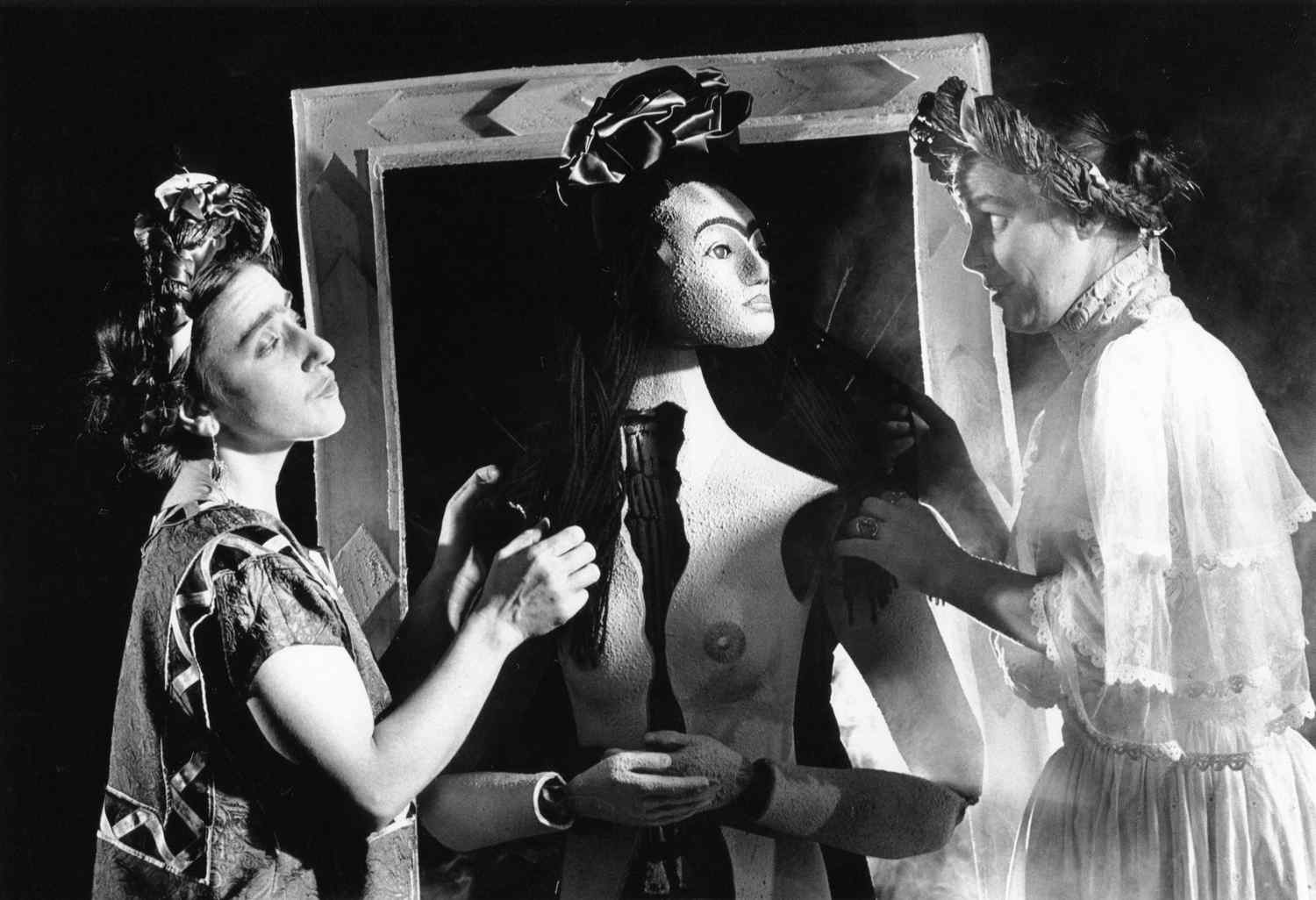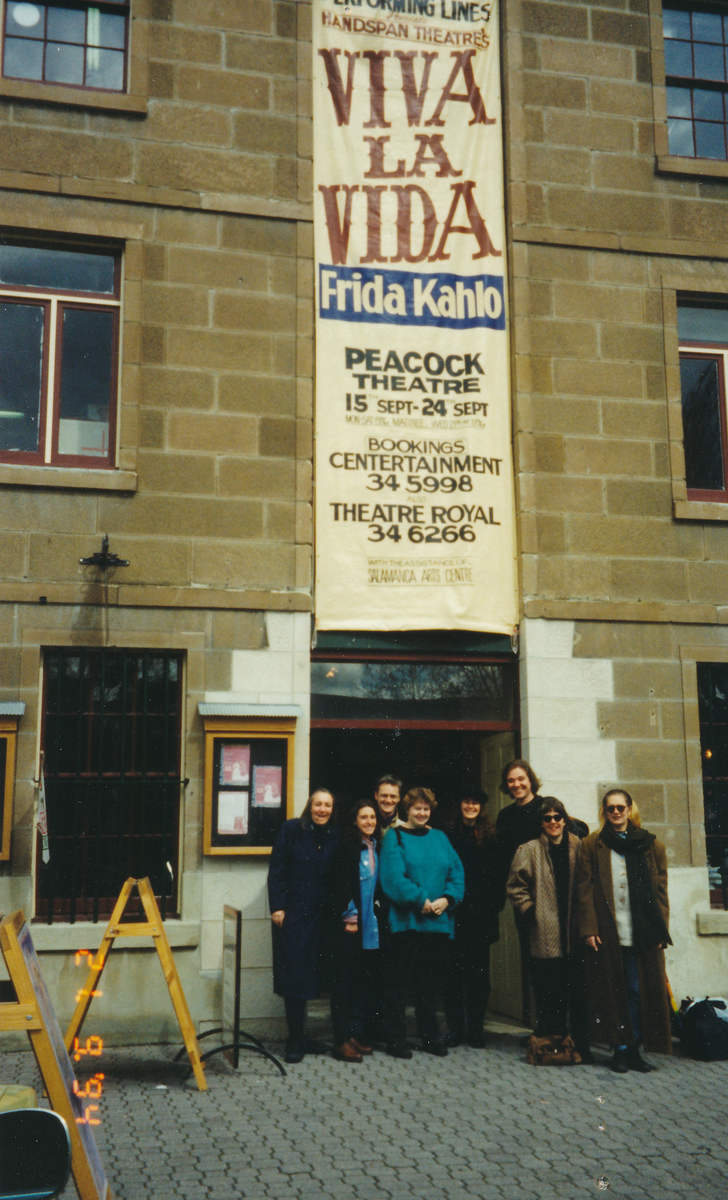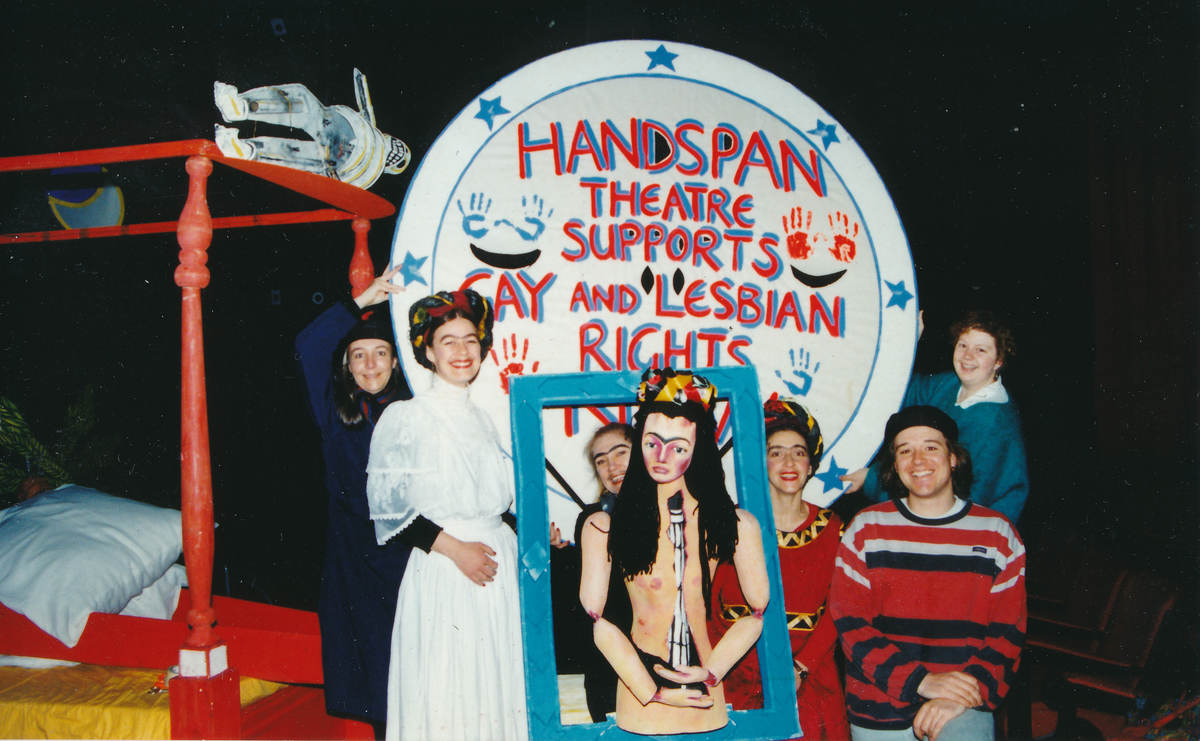| Premiere | 29 April 1993 |
| Venue | The Gasworks Theatre, Albert Park, Victoria |

VIVA LA VIDA - FRIDA KAHLO celebrated the life of Mexican painter Frida Kahlo.
Written by Karen Corbett, composed by Boris Conley and directed by Angela Chaplin, the play depicted the duality of Kahlo’s life as had Kahlo herself, in her painting: The Two Fridas. Designed by Ken Evans with Cliff Dolliver and Lighting designer, Philip Lethlean was the second of Handspan’s major works inspired by the work of a visual artist1 .
Frida Kahlo's painting life began after a street accident further crippled and deformed her already polio affected body. She painted subject matter familiar to her, often, herself. On stage, the European Frida and the Mexican Frida, equally eccentric personalities, struggled for supremacy in the drama and passion of Kahlo's stormy and pain-raddled life with her husband, revolutionary muralist Diego Rivera.
In her submission to Handspan for production of the work in 1991, Corbett outlined her vision:
I am specifically interested in depicting Frida’s growth from a reactionary middle-class girl to a mature, independent, politically conscious woman. I hope to de-bunk the ‘suffering artists’ myth and show how Frida used it as a fantasy, as well as her pain, as a catalyst to produce some of the most important artwork of this century.
Kahlo's last painting was titled: Viva La Vida (Long Live Life), hence Corbett's title of the work, which aimed to celebrate that life. Seeking to stage the underlying ‘dream dialogue’ of Kahlo's painted life with animated imagery, Corbett proposed the work to Handspan who she knew 'had been refining this kind of performance dialogue for many years'2
. Handspan took on the project. Corbett took herself to Mexico find Frida there, and on her return, wrote the script.
Capturing the artist
The play, developed in 1993, translated Corbett’s concepts into the rich imagery of Kahlo’s pictures which interpreted the work and were its hallmark.
Samela Harris reviewed its 1994 season:
The Handspan puppets, from towering walking death to Frida’s self-portrait, are fastidious stage re-creations of Kahlo’s art imagery…Handspan uses all the tricks of the theatre to create not only a living and exciting dramatic work but to capture the very art of Kahlo in varied brief static moments. It is this melding of theatre and visual art that makes Viva La Vida Frida Kahlo a truly thrilling theatre piece.
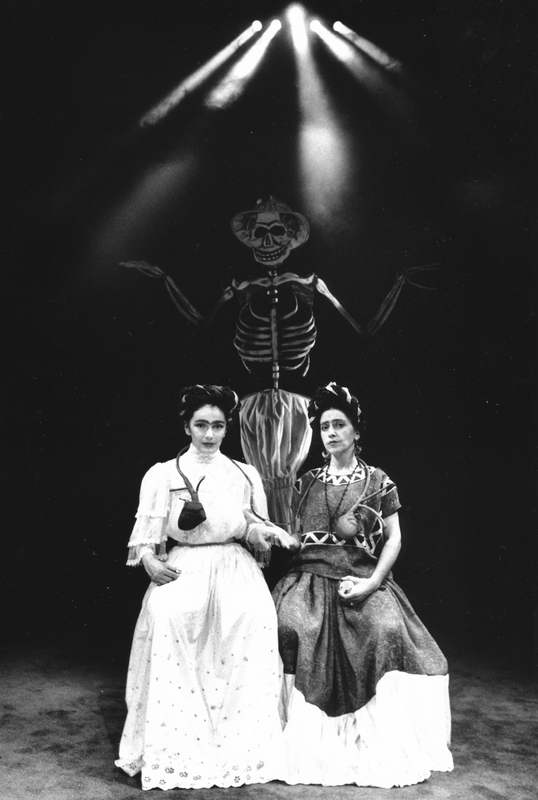
In the play, the two Fridas were played by actors who had the only spoken words in the play. A third Frida, a puppet character was (according to performer Carmelina Di Guglielmo) 'the glue, in some ways, between them, something they both had in common from the very beginning whether they both understood it or not'3 . Riviera was represented by huge legs in pin-stripe trousers; skeletons loomed large; an Uncle Sam-like Henry Ford floated; and Frida’s bed (of pain) was a central focus.
The production with its arresting images and grotesque puppets … is like one long, surrealist painting and for that alone is well worth seeing.
VIVA LA VIDA's design represented not only Frida’s paintings, but also derived from Mexican folklore and the imagery seen on the streets of Mexico on the Day of the Dead.
The play was performed to an original soundtrack by Melbourne composer Boris Conley who had previously composed the score for Handspan’s original production of Cho Cho San (1984). Like the design, the score sourced Mexican tradition and blended folk music, some of it based on street recordings made by Corbett in Mexico, into its soundscape.
Striking responses
Reviews were predominantly raves and always the puppetry and staging were applauded as magical although some critics didn’t enjoy the onstage smoke – a signature masking device in Handspan’s works. Several critics, whilst effusive about the work overall, questioned the efficacy of the form and its marriage of images and text:
It's brilliantly conceived, full of delicious symbolism, and Handspan's puppetry is peerless - but the form rather than the substance stays with you afterwards
This production is both striking and flawed. Its flaws are accentuated by its strengths which is appropriate considering the strengths and flaws of Kahlo's life and work
Angela Bennie's review tried to identify the rationale for critics' mixed response:
At the level of text, performance and direction, Viva La Vida is a rather tiresome journey through the facts of Frida's life. High above them, sitting like a metatext above them, is what might be called the work's fourth dimension, a glowing, colourful, exotic, wild testament to Frida Kahlo. The fourth dimension is peopled by puppets ... which when they appear, transform this work and take it up beyond the ordinary into extraordinary, into the rare and the fearsome, the magical and poetic''
Doubts aside, everyone recommended it as a 'must see':
.. the pluses - and Ken Evans design is a big plus - outweigh the negatives. The images remain vivid in my mind and I left the theatre quite exhilarated
The politics were a bit simple for this old Trotskyite reviewer, but we recommend Viva La Vida as a show that knows its theatre, looks fantastic, and doesn't pretend to be a movie
VIVA LA VIDA ... was first performed in Melbourne in 1993 and, with some cast changes, toured to three States in eastern Australia for Performing Lines in 1994.
Footnotes:
| Creative team | |
|---|---|
| Writer | Karen Corbett |
| Director | Angela Chaplin |
| Designer | Ken Evans |
| Assistant designer | Cliff Dolliver |
| Lighting designer | Philip Lethlean |
| Composer | Boris Conley |
| Costume design | Kym Williams |
| Sound design | Peter Jago |
| Performers | |
|---|---|
| European Frida | Melita Jurisic (1993), Jane Bayly (1994) |
| Mexican Frida | Carmelina Di Guglielmo |
| Puppeteer | Avril McQueen |
| Puppeteer | Katy Bowman (1993), Mary Sutherland (1994) |
| Puppeteer | John Rogers (1993), Peter Seaborn (1994) |
| Puppeteer | Michele Spooner |
| Production team | |
|---|---|
| Production/stage Manager | Mikkel Mynster (1993), Marnie McDonald (1994) |
| Mexican language consultant | Leopoldo Conchello |
| Dramaturgical assistance | Michael Wansborough |
| Movement assistance | Dianne Reid |
| Scenic artist | Horse |
| Set & puppet construction | Cliff Dolliver, Rod Primrose, Mary Sutherland |
| Construction assistants | Traleen Ryan, Philip Emmett, Michael Heap, Davin Baker, Andrew Johnston, Andrew Nelmes, Priscilla Johnston |
| Costume construction | Kym Williams, Lindy Macauley |
| Program design | Fiona Sweet |
| Graphic artist | Rodney Oliver |
| Photographer | Ponch Hawkes |
| Seasons | |
|---|---|
| 1993 | |
| 29 April - 22 May 1993 | Gasworks Theatre, Albert Park Victoria |
| 1994 | Performing Lines Tour |
| 31 August - 10 September | Space Theatre, Adelaide Festival Centre, SA |
| 15 - 24 September | The Peacock Theatre, Hobart, Tasmania |
| 29 September - 9 October | The Performance Space, Sydney, NSW |
| Total performances | Unknown |
| Total audience | Unknown |

